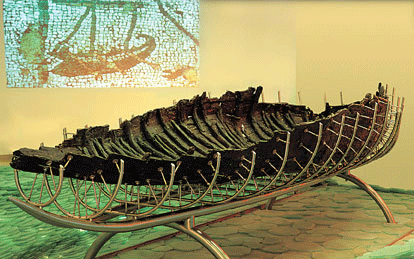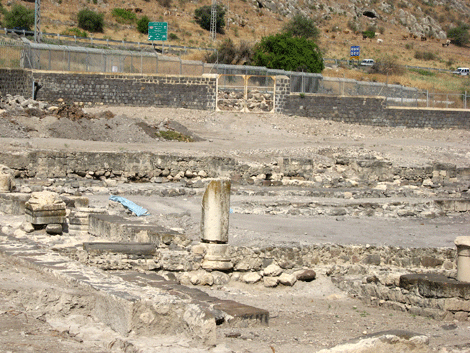|
 |
|
 |
|
Mary of Magdala from whom Jesus had cast out
seven demons had a surprising, very
unbiblical role in author Dan Brown’s
best-selling fantasy, “The Da Vinci Code.”
In the aftermath of the success of the 2003
novel, Magdala, Mary’s hometown a few miles
north of Tiberias on the western shore of
the Sea of Galilee, attracted a surge of
curiosity seekers and cult followers. |
|
|
|
 |
|
Copyright
2013 by Gila Yudkin |
|
Map of Galilee showing
prominent towns in Jesus' day |
|
|
This may be one of the major reasons Magdala
is now gated and off-limits to authentic
pilgrims wanting a place to revere Mary
Magdalene. Mary Magdalene is first named of
the women who brought spices to anoint
Jesus’ body after the Sabbath. Some scholars
even suggest that the unnamed sinner in Luke
7 who bathed Jesus’ feet with her tears and
then anointed them with ointment was Mary
Magdalene.
In 2008 Magdala was excavated by Father
Stephano de Luca of the Franciscan Order. His most noted find were perfume vials from
the first century AD, found at the bottom of
an ancient swimming pool.
|
|
|
|
"The mud-filled condition of the site
allowed us to find these truly extraordinary
objects, which were intact and sealed and
still contain greasy substances,” declared
Father Stephano to an Italian paper. "We
think these are balms and perfumes and if
chemical analysis confirms this, they could
be similar to those used by Mary Magdalene
in the Gospels to anoint the feet of
Christ..” |
|
|
|
Father Stephano added that even if Mary
Magdalene was not the woman of Luke 7, "it's
very likely that the woman who anointed
Christ's feet used these ointments, or
products that were similar in composition
and quality.” |
|
|
|
 |
|
Photo:
Gila Yudkin |
|
Magdala as seen from Mount
Arbel lies at the bottom right corner |
|
|
|
It was nearby at the Magdala shore in 1986,
that two fishermen from Kibbutz Ginosar
carrying metal detectors in search of
ancient coins discovered an old fishing
boat. That fishing boat was believed to have
been lying at a boat repair shop one first
century AD winter when a flash flood gushed
down towards the sea and covered the boat
with sand. Since the discovery, that boat
has been meticulously preserved and you may
have seen it on display during your Holy
Land tour. |
|
|
|
 |
|
Courtesy of
Jesus Boat Shop |
|
First century AD fishing boat
found by the shores of Magdala in 1986 |
|
|
|
Magdala at the time of Mary was a thriving
harbor city, described by Josephus the
Roman/Jewish historian as a place full of
materials for shipbuilding and with many
artisans. The Roman geographer Strabo wrote
that Tarichae (Magdala’s name in Greek which
means the place where fish are prepared)
excelled in pickling fish. Large quantities
of pickled fish from Galilee were taken up
to Jerusalem for the annual pilgrimage
feasts when the city was crowded with
pilgrims. Barrels of pickled fish from Magdala were transported around the
Mediterranean. |
|
|
|
But Magdala was destroyed during the revolt
of the Jews against the Romans in 67 AD. According to Josephus, so many of the city’s
defenders were slaughtered, that the sea
turned a color of bloody red. According to
the rabbis in the Jerusalem Talmud, Magdala’s defeat had been caused by the
residents’ immorality. The city never
recovered.
|
|
|
|
 |
|
Photo:
Gila Yudkin |
|
Ruins at Magdala in 2009 |
|
|
|
In 2009, in exploratory excavations before
the Pontifical Notre Dame of Jerusalem
Center laid the foundations for a Magdala
Center on the site, a synagogue was
discovered from the Second Temple period,
with its date ranging from 50 BC to 100 AD. According to the archeologist, Dina Avshalom-Gorni, this synagogue is one of
only seven in the world dating to the Second
Temple period. |
|
|
But the real surprise was a stone found in
the center of the synagogue. It's engraved
with a seven-branched menorah set atop a
pedestal with a triangular base which is
flanked on either side by amphora (large
storage jars). We assume that the artist who
engraved the menorah saw the 7-branched gold
menorah standing in Jerusalem's Temple. |
|
|
 |
|
Photo:
Gila Yudkin |
|
Menorah relief found in
middle of Magdala's synagogue of Jesus' day |
|
|
And no doubt that Jesus, who was
headquartered at Capernaum about five miles
down the road along the shore of the Sea of
Galilee, would have visited this synagogue! |
|
|
|
Stay tuned as the building of the Magdala
Center progresses and hopefully when it
opens we will be able to drop by the
synagogue in Mary Magdalene's home town. In
the meantime, let’s mention Mary Magdalene
as we drive by her home turf on the western
shore of the Sea of Galilee. |
|
|
|
Copyright 2009, 2013 Gila Yudkin. Permission
needed for any reuse. |
|
|
|
Gila Yudkin,
a holy land guide for over thirty years, is
always on the lookout for new angles on
ancient sites. She loves working with
groups thirsty for biblical insight,
archeological anecdotes and old-fashioned
fun. She wishes she could have been Mark
Twain’s tour guide way back in 1867. |
|
|
|
When American humorist Mark Twain visited
the Holy Land, Magdala was on his itinerary. Tongue in cheek he vividly described being
greeted by its blind, crazy, and crippled
residents, all begging for baksheesh. |
|
|
|
Then he wrote that he and his entourage
“filed through the town with many exquisite
frescoes till we came to a bramble-infested
enclosure and a Roman-looking ruin which had
been the veritable dwelling of St. Mary
Magdalene, the friend and follower of Jesus. The guide believed it, and so did I. I could
not well do otherwise, with the house right
there before my eyes as plain as day. The
pilgrims took down portions of the front
wall for specimens, as is their honored
custom, and then we departed.” |
|
|
|
Perhaps that’s why Magdala’s ruins are so
sparse today! If you are a Mark Twain fan,
or contemplating a holy land tour, see
Mark Twain's Tips for Holy Land Pilgrims for travel
tips relevant for contemporary holy land
pilgrims. |
|
|
|
In 1838,
Edward Robinson, the Connecticut
Yankee considered the
father of biblical
geography, visited Magdala while
searching for the ruins of Capernaum, the
headquarters of Jesus’ Galilean ministry.
|
|
|

